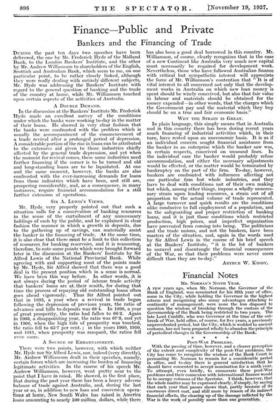SIR A. LEWIS'S VIEWS.
Mr. Hyde_ very properly pointed out that such. a situation calls for a conservation of banking resources in the sense of the curtailment of any unnecessary holdings of cash by the public, and he explained in clear fashion the manner in which a growth in deposits, due to the gathering up of savings, can materially assist the banker in the financing of- trade. At the same time, it is also clear that there must be a limit to this collection of resources, for banking reservoirs, and it is reassuring, therefore, fo note some points which were brought forward later in the discussion at _the . Bankers' Institute by Sir Alfred Lewis of the National Provincial Bank. While agreeing with and supporting most of the points made by Mr. Hyde, Sir Alfred showed that there was a good deal in the ,present position which in a sense is normal. We have beeii this way before. In other words, it is not always during the period of intense trade activity that bankers' loans arc at', their zenith,- for during that time the process of repaying- old outstanding loans often goes ahead vigorously. Thus Sir Alfred pointed out that in 1895, a year when a revival in trade began following -the depression of previous years, the ratio of advances and bills to deposits was 68'4. In 1898, a year of great prosperity, the ratio had fallen to 66'2. Again in 1903, a disappointing year, the ratio was 67.3, and yet in 1906, when the high tide of prosperity was touched, the ratio fell to 65/ per cent. ; in the years 1909, 1910, and 1911, when prosperity was rampant, the ratios fell even more.














































 Previous page
Previous page